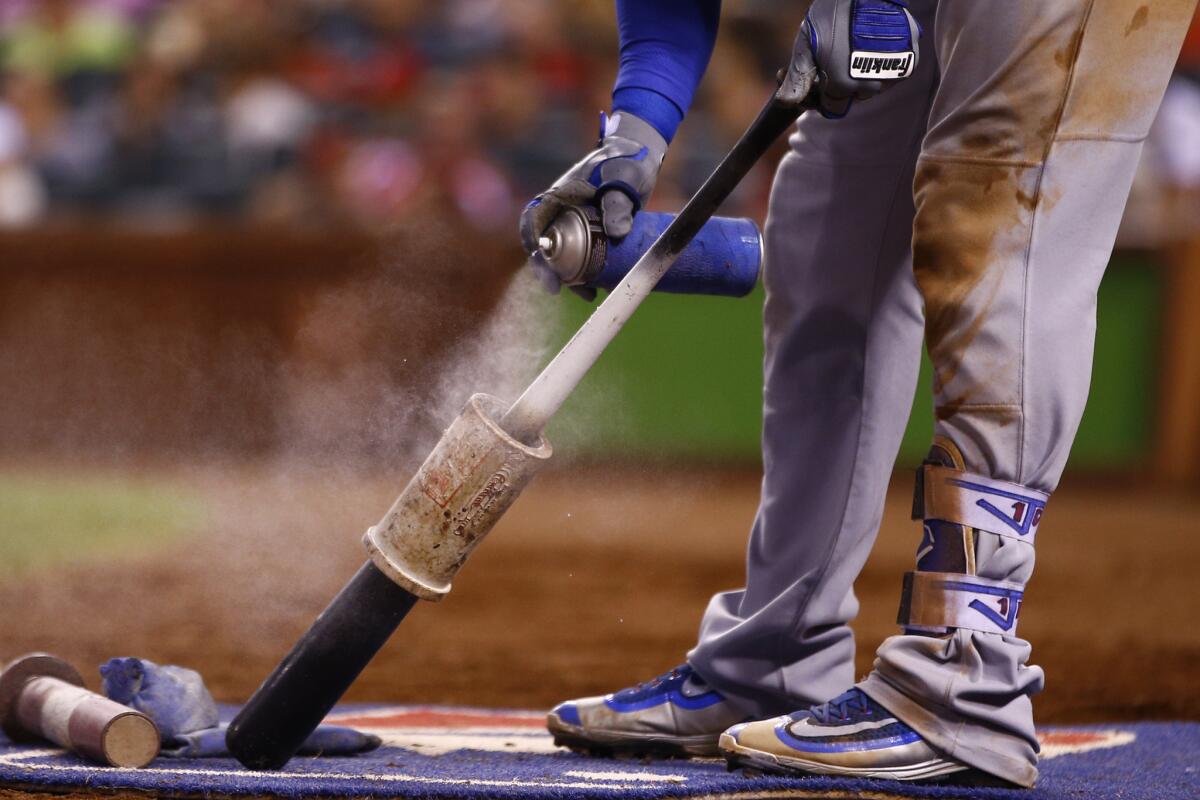The evolution of Justin Turner: How a bench player in New York became a Dodgers star

- Share via
The ritual begins when Justin Turner unsheathes his 31.5-ounce Rawlings bat from the rack and strides through the dugout.
When he was still a teenager, he learned the importance of a routine, and so he stands on the steps, near Dodgers Manager Dave Roberts, repeating a set of actions ingrained in his memory.
Turner inverts the bat and claps the knob against the three steps separating him from the diamond. Middle step, top step, middle step, bottom step, middle step, then a last whack for the padding on the railing, a concussive noise that reminds Roberts of a barrel striking a ball.
“Man,” Roberts tells him, every single time, “I love that sound.”
Turner walks toward the on-deck circle and hits his cleats four times or more. He straps a weighted doughnut onto the lumber and sprays a white chalk adhesive across the handle. He faces the crowd and takes two warm-up cuts. He turns around and watches the action at the plate, regulating his breathing to steady his pulse.

When his turn to hit arrives, Turner takes two more practice swings. He adjusts his gloves and digs into the batter’s box. He sweeps the dirt with his right foot. He steps out, taps his feet with his bat, holds the barrel aloft, staring into it. Then he inhales deep and returns to the box.
“I got a chance to re-create my whole identity when I came over here,” Turner said, and each step of his route to the plate reveals the keys to his evolution: The breathing techniques he learned on the field and in the classroom at Cal State Fullerton. The swing he rebuilt after the New York Mets released him in 2013. The physique he reshaped after his first season in Los Angeles. The knee he rehabilitated from microfracture surgery last winter, emerging from the process a sleeker defender with more power than ever before.
After three seasons as a Dodger, Turner can now consider himself a member of the game’s elite. Since signing a minor-league contract with Los Angeles in 2014, his .864 on-base plus slugging percentage ranks 21st among hitters with at least 1,000 plate appearances. He resided at No. 20 among position players in FanGraphs’ version of wins above replacement before Monday’s games.
An eight-figure payday awaits Turner, 31, this winter in free agency. He wants to remain with the Dodgers. He grew up about 30 minutes south of Dodger Stadium, where he’s become a player who outshines the statistical expectations for his position while enhancing the clubhouse chemistry. Roberts considers him one of the most influential voices on the roster.
“J.T. is the epitome of what we’re trying to do going forward, the type of baseball player he is, what he stands for,” Roberts said. “Those are the guys you win with.”
One day this winter, shortly before he reported to Camelback Ranch, Turner went to lunch with a retired kinesiology professor named Ken Ravizza. Ravizza is considered a titan in the field of sports psychology, a consultant with teams such as the Angels, Chicago Cubs and Tampa Bay Rays for three decades. When Howie Kendrick slumped through May, he called Ravizza.
J.T. is the epitome of what we’re trying to do going forward, the type of baseball player he is, what he stands for. Those are the guys you win with.
— Dodgers Manager Dave Roberts
Ravizza met Turner while teaching at Cal State Fullerton, where he also aided the baseball team. He considers Turner “almost like a son to me.” During four years together, Turner enrolled in a pair of Ravizza’s classes, a course on sports psychology and a course on stress management. In one session, Ravizza went around the room and asked the athletes about motivation.
“I play my sport,” Turner told the group, “because I love going to Omaha,” the site of the College World Series.
Ravizza considered Turner a ravenous study at psychology. “He came to class!” Ravizza said. Turner appreciated how Ravizza encouraged his students to fail and “see that life goes on,” Turner said.
On the diamond, Ravizza helped Turner build mechanisms to combat the havoc baseball can create. Turner developed a routine that acts as his anchor, absorbed relaxation techniques to calm himself during crises and learned breathing techniques to “really focus on taking one breath at a time, which related back to playing one pitch at a time,” Ravizza said.
“It’s a routine that allows him to give 100% of what he’s got to win the next pitch,” Ravizza added. “I really think that’s what he is about: Winning the next pitch.”
Turner played well in college, but his physical profile was unremarkable. He hit eight home runs in four seasons, and scouts doubted he could handle shortstop in the majors. Drafted in the seventh round of the 2006 draft, he bounced from Cincinnati to Baltimore to New York. He spent three seasons as a reserve for the Mets, painting himself into a corner as a useful but expendable asset.

The tide started to shift in 2013 when the Mets signed Marlon Byrd, a well-traveled outfielder who would accept a 162-game suspension in 2016 for repeated violations of baseball’s performance-enhancing drug policy. Turner impressed Byrd with his knowledge of the craft, as he lamented his inability to translate the insight into production.
“I felt like I took great at-bats, and had a chance,” Turner said. “I just, mechanically, wasn’t very efficient to do any damage.”
Byrd invited Turner to spend the winter with him and his hitting guru, Doug Latta, who ran a facility in Chatsworth. Latta suggested an overhaul of his swing that spanned both mechanics and philosophy. Turner had always tried to keep his weight back and slap grounders. Latta encouraged him to lower his hands and transfer his body forward to launch the baseball.
When Turner finished his first session, Latta turned to Byrd, wowed by Turner’s hand speed. “Does he know what an impact player he can be?” he asked. Within a month, Turner started to feel comfortable with the adjustment. He was beginning to wrap his mind around his future as a slugger.
“Once that feel starts getting better, confidence builds,” Latta said. “Timing gets better. You see the ball better. Now add that up to a hitter.”
The transformation excited Turner and it worried him. He felt capable of punishing pitchers like never before, but he had yet to experience success in games. When the Mets cut him loose before 2014, the Dodgers invited him to camp because he could play different positions and hit off the bench, not because they expected him to supply power. Turner was gambling that his new approach would convince them otherwise.
Turner called Latta that spring to tell him about ripping six consecutive homers during batting practice. When Latta started to congratulate him, Turner interrupted to finish the story. “One of the guys gave him flack, like, ‘That’s not your game,’” Latta said. “You get this disconnect. But all those things fueled J.T.”
Turner made the club and became a reliable contributor. He appeared at every infield position and posted an .897 OPS. He batted .400 as a pinch-hitter and .419 with runners in scoring position. He caught the attention of strength and conditioning coach Brandon McDaniel, who marveled at Turner’s skills, but noticed his physical limitations.
“I didn’t feel like he had the ability to play nine innings at a high level,” McDaniel said. “Let alone every day.”
McDaniel offered to move to Los Angeles from his home in Nebraska to train Turner that winter. By December, the two were meeting six days a week at Dodger Stadium. McDaniel threw him batting practice, hit him grounders and paced him through conditioning drills. The activity improved his dexterity in the field, stripping inefficiencies from his movements so that “the way he plays third base now, it’s a difference-maker for us,” McDaniel said.
Turner became wedded to the schedule. When he spent Christmas with his girlfriend outside Chicago, McDaniel designed a plan for him to work out at Valparaiso University “so I didn’t miss anything,” Turner said.
The changes extended to his diet. McDaniel advised Turner to cut out refined carbohydrates and increase his intake of “healthy fats” like almond butter, avocados, coconuts and olive oil. Turner lost nearly 20 pounds.
“There were times that first offseason where he figured it out and started losing weight so fast that I was like, ‘I’ve got to pick it up. You’re making me look bad,’” McDaniel said.
After Turner blossomed into a star last season, the ethic established with McDaniel created a framework for recovery this past winter. His knee had bothered him for years, and surgery kept him off his feet for nearly two months. As he recovered, the training staff sought to keep Turner’s gait even, while maintaining the balance of strength between the two legs.
Turner was ready for opening day. But he started slow unable to lift the baseball, and by the second week of June, his batting average hovered at .220. Searching for an answer, he ditched his 34-ounce bats for a lighter model used by Chase Utley. Rather than fall into old habits, he reinforced the need to put the ball in the air.
“He understands his swing, and he understands his strengths,” hitting coach Turner Ward said. “It’s about him being in a good body position so he can get the elevation.”
The parts came into sync on June 8, when Turner smashed a game-winning homer in San Francisco. He started a tear that has yet to abate. Since June 26, the day of Clayton Kershaw’s last start, Turner has hit .315 with 10 homers and 30 RBI.
The evolution of Justin Turner did not occur overnight. He built himself for stardom from the top down: the brain, the swing and the body, unwilling to settle for a career as a minor-key major-leaguer. At his core, Ravizza explained, Turner still resembles that undergraduate who thirsted for Omaha.
“He was always open to learning,” Ravizza said. “He never had all the answers, and still doesn’t. He’s a real warrior. He’s a competitor, man. And he wants to get better all the time.”
ALSO
Column: Dave Roberts isn’t missing a beat in first year as Dodgers manager
Dodgers mailbag: Is the starting rotation cursed?
Sometimes NBC’s Olympics coverage gets it absolutely right
More to Read
Are you a true-blue fan?
Get our Dodgers Dugout newsletter for insights, news and much more.
You may occasionally receive promotional content from the Los Angeles Times.








